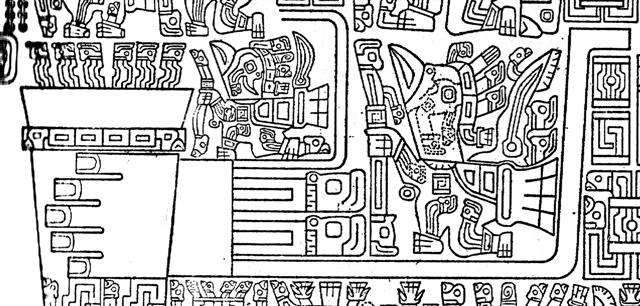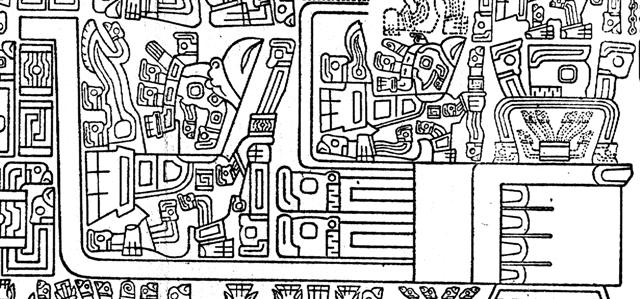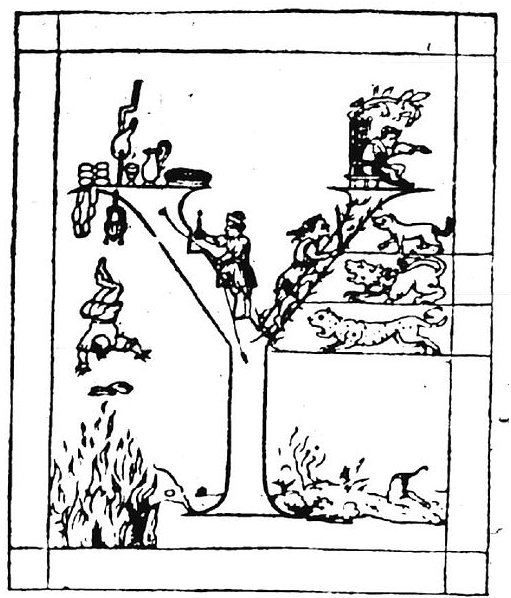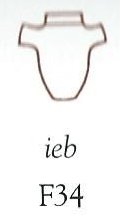What might happen to someone who tries to move ahead instead of following the ecliptic path down to Spica? There appeared to be alternatives, because Virgo had one arm up and one arm down before there was the division (vae) at ζ (Heze), with one leg (vae matau) above and the other below (vae maui) the equator:
Thus there might have been a pair of 'change stations' also at Virgo. ... Considering the fact that the crossroads of ecliptic and Galaxy are crisis-resistant, that is, not concerned with the Precession, the reader may want to know why the Mangaians thought they could go to heaven only on the two solstitial days. Because, in order to 'change trains' comfortably, the constellations that serve as 'gates' to the Milky Way must 'stand' upon the 'earth', meaning that they must rise heliacally either at the equinoxes or at the solstices. The Galaxy is a very broad highway, but even so there must have been some bitter millenia when neither gate was directly available any longer, the one hanging in midair, the other having turned into a submarine entrance ... ... There was once an Indian who was married and the father of a boy and a girl. The Trickster, who wanted to appropriate his fine garments and his wife, persuaded him to go and fetch eaglets from the top of a high peak. The Indian took off his clothing and started to climb up the cliff, which he found quite an easy task, since the way to the nest was like a stairway. But the Trickster commanded that the peak increase in height. He made the sides completely smooth so that the Indian was unable to come back down and remained stranded at the top. The Trickster did not attempt (as in Salish mythology) to assume the outward appearance of his rival. He related what had happened but said nothing of the part he himself had played, and claimed that the hero, before disappearing, had told him to take care of his wife and children. The wife consented but it was not long before her new husband started to scold his stepchildren without cause or reason. Such is the feeling with the stepfather or stepmother for children. The woman, who loved her children and was unhappy to see them being ill-treated, decided to divulge the suspicious circumstances in which her husband had disappeared. Everybody went to the foot of the peak which was strewn with beads; these were the tears shed by the hero who had wept for days and nights. They called upon the wild geese to help: they flew to the top, put the man on their backs and landed him safely. He was at once comforted and cared for; he recovered his health and strength. He then set off to look for his wife and children; he found them again and gave them food, for his rival had deprived the children of food in the hope that they would quickly die of hunger. The hero then hid in a meat sack, jumped on the Trickster and killed him. The corpse was cut up and the pieces scattered. However, the Trickster came back to life. He went away and stopped to rest by a lake, and meditated on death: should death be final or not? On seeing that a stick, then a buffalo turd, and lastly a piece of pith remained afloat after he had thrown them into the lake, he opted for resurrection. However, when a pebble sank, he reversed his decision. It was better that people should die, he concluded, otherwise the earth would quickly become overpopulated. Since that time, people only live for a certain period and die for ever ... Vindemiatrix (ε) culminated at midnight in MARCH 19 (78) and in Gb5-10 we can imagine a left ear (sign of looking back):
Possibly the right ear of Pachamama (above) was like an entrance for the Ship of the Sun. But her left ear was designed the same, allowing for the same kind of interpretation for those who were living south of the equator and had their spring beginning at the opposite side of the globe (her head). In general Pachamama was designed with left-right symmetry, although with a few notable exceptions. In addition to the assymmetry in her tresses there was for instance the more obvious difference between her left and right hands - one open with its back towards us holding a steaming cup and the other closed with its thumb pointing to the left:
Vindemiatrix (the Grape Gatherer) rose a pair of days before the Child of the Waters (Apami-Atsa, θ) which in turn was close to the Full Moon in "February 23:
The creator of the G text could have meant Heze was the origin of a path straight up. At the complementary lady close to the Full Moon was υ Andromedae (at the apex of the 3 stars in the shadows under her left knee):
... By repeating a charm, she opened the two shells and slipped inside. She could see nothing, because the sun and the moon did not then exist; and then, she could not stand up because there was not enough room in the shellfish. Constantly hunting about she at last found a snail. To endow it with power she placed it under her arm, lay down and slept for three days. Then she let it free, and still hunting about she found another snail bigger than the first one, and treated it in the same way ...
The Chinese began their list with Spica and then came κ Virginis (214 days after 0h). And for some - with the right timing - there might have been a way forward through the dark region:
... An important part of the Egyptian soul was thought to be the Ib (jb), or heart. The Ib or metaphysical heart was believed to be formed from one drop of blood from the child's mother's heart, taken at conception.
To ancient Egyptians, the heart was the seat of emotion, thought, will and intention. This is evidenced by the many expressions in the Egyptian language which incorporate the word ib, Awt-ib: happiness (literally, wideness of heart), Xak-ib: estranged (literally, truncated of heart). This word was transcribed by Wallis Budge as Ab. In Egyptian religion, the heart was the key to the afterlife. It was conceived as surviving death in the nether world, where it gave evidence for, or against, its possessor. It was thought that the heart was examined by Anubis and the deities during the Weighing of the Heart ceremony. If the heart weighed more than the feather of Maat, it was immediately consumed by the monster Ammit ... Ammit lived near the scales of justice in Duat, the Egyptian underworld. In the Hall of Two Truths, Anubis weighed the heart of a person against the feather of Ma'at, the goddess of truth, which was depicted as an ostrich feather (the feather was often pictured in Ma'at's headdress). If the heart was judged to be not pure, Ammit would devour it, and the persons undergoing judgement was not allowed to continue their voyages towards Osiris and immortality. Once Ammit swallowed the heart, the soul was believed to become restless forever; this was called 'to die a second time' ...
... In the inscriptions of Dendera, published by Dümichen, the goddess Hathor is called 'lady of every joy'. For once, Dümichen adds: Literally ... 'the lady of every heart circuit'. This is not to say that the Egyptians had discovered the circulation of the blood. But the determinative sign for 'heart' often figures as the plumb bob at the end of a plumb line coming from a well-known astronomical or surveying device, the merkhet. Evidently, 'heart' is something very specific, as it were the 'center of gravity' ... See Aeg.Wb. 2, pp. 55f. for sign of the heart (ib) as expressing generally 'the middle, the center'. And this may lead in quite another direction. The Arabs preserved a name for Canopus - besides calling the star Kalb at-tai-man ('heart of the south') ... Suhail el-wezn, 'Canopus Ponderosus', the heavy-weighing Canopus, a name promptly declared meaningless by the experts, but which could well have belonged to an archaic system in which Canopus was the weight at the end of the plumb line, as befitted its important position as a heavy star at the South Pole of the 'waters below'. Here is a chain of inferences which might or might not be valid, but it is allowable to test it, and no inference at all would come from the 'lady of every joy'. The line seems to state that Hathor (= Hat Hor, 'House of Horus') 'rules' the revolution of a specific celestial body - whether or not Canopus is alluded to - or, if we can trust the translation 'every', the revolution of all celestial bodies. As concerns the identity of the ruling lady, the greater possibility speaks for Sirius, but Venus cannot be excluded; in Mexico, too, Venus is called 'heart of the earth'. The reader is invited to imagine for himself what many thousands of such pseudo-primitive or poetic interpretations must lead to: a disfigured interpretation of Egyptian intellectual life ... |
|||||||||||||||||||||||||||||||||||||||||||||||||||||||||||||||||||||||||||||||||||||||||||||||||||||||||||||||||||||||||||||||||||||||||||||||||||||||||||||||||||||||||||||||||||||||||||||||||||||||||||||||||||||||||||||||||||||||||||||||||||||||||||||||||||||||||||||||||||||||||||||||||||||||||||||||||||||||||||||||||||||||||||||||||||||||||||||||||||||||||||||||||||||||||||||||||||||||||||||||||||||||||||||||||||||||||||||||||||||||||||||






















